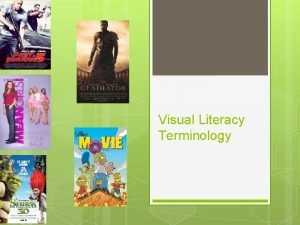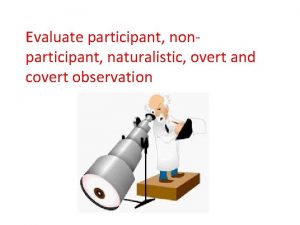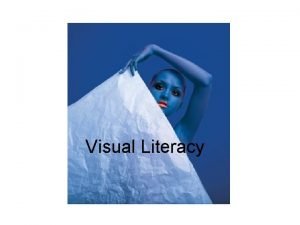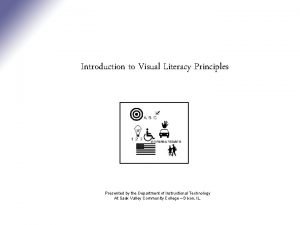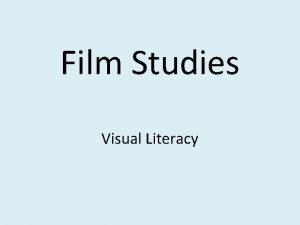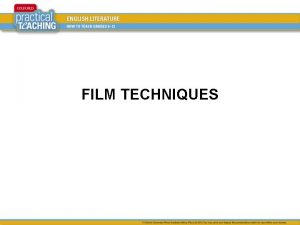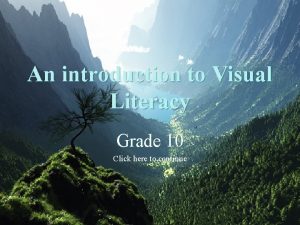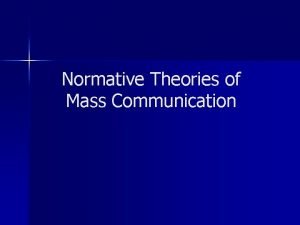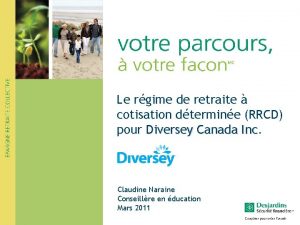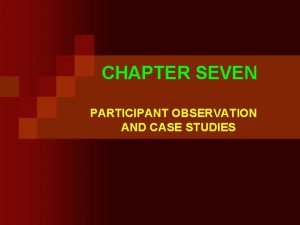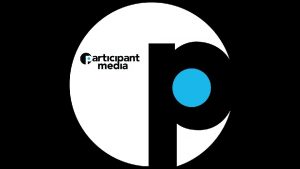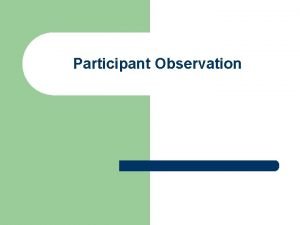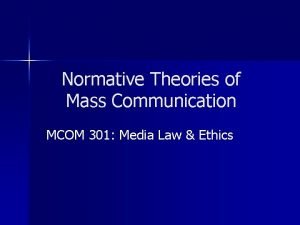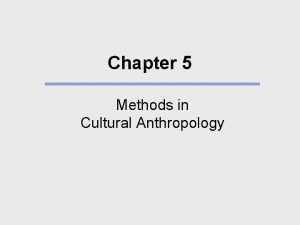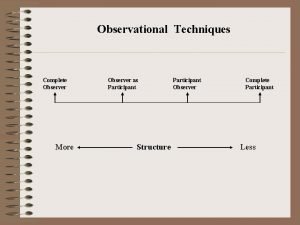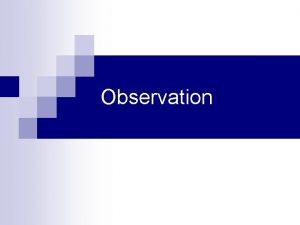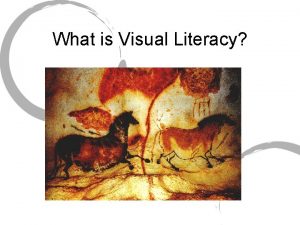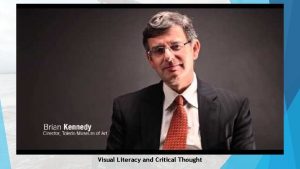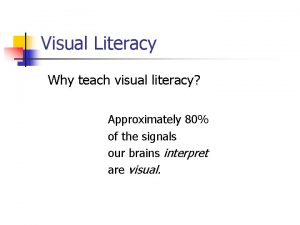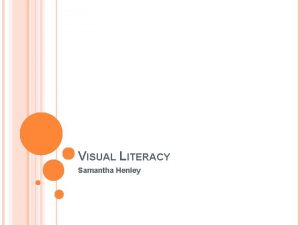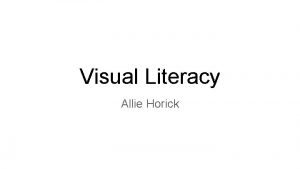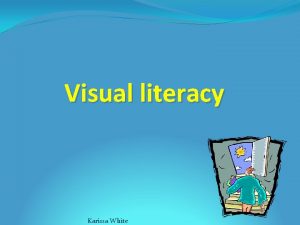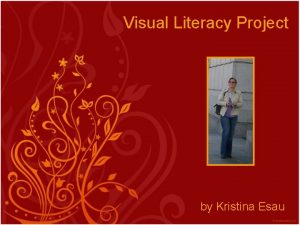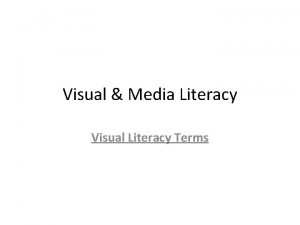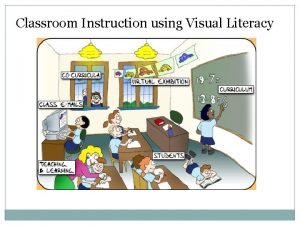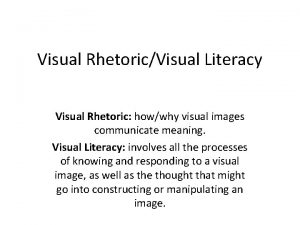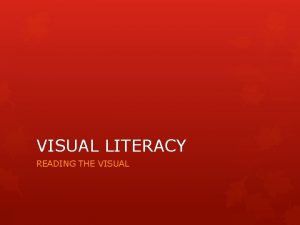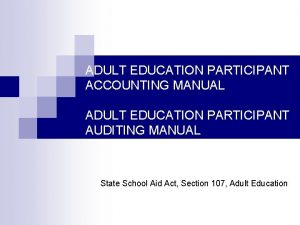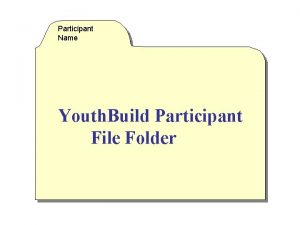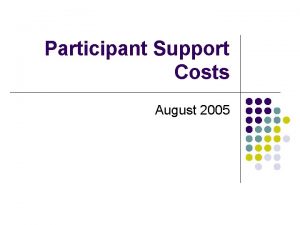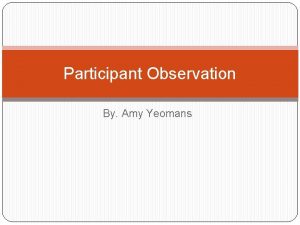Visual Literacy Terminology Participant Who and what is





































- Slides: 37

Visual Literacy Terminology

Participant Who and what is represented

Gaze Demand – when the participant looks directly at the viewer, demanding a response. Can be engaging or confronting Offer – occurs when the participant looks away from the viewer, and is more impersonal

Offer Demand

Salience The part of an image that first attracts the viewer’s attention is most salient The most notable feature in the text This could be due to size or colour


Centrality The placing of the central figure/object to focus attention


Social Distance The distance between the participant and the viewer, representing a type of relationship Close= intimate relationship Medium= social relationship Long/far= public relationship

Close/Intimate Long/Public Medium/Social Long/Public Close/Intimate

Power Relations (Angle) The angle of an image positions the viewer as: Having superior knowledge or power (taken from above) Having inferior knowledge or power (taken from below) Having equal standing with the participant (taken at eye-level)

Eye-Level Slight Low angle Eye-Level Slight High angle High Angle Low angle

Framing The border enclosing the main part of the text

Framing around the image- looks like a photo Framing – sparkling love heartpretentious, conceited Rough, black frame. Symbol of hate, evil spreading into their lives

Vectors Lines that direct the viewer’s gaze through a visual text. This can be a solid line, or the gaze of the participant directing the viewer’s attention.


Composition Foreground=objects/participants at the front of the image Middleground= objects/participants in the middle of the image Background= objects/participants at the back of the image

F B B F M M B M F F B F

Information Value Where something is placed within a text to convey certain value In Western Society we read from left to right and top to bottom Left to right layout= given/new Top to bottom layout=ideal/real Centre to margin layout= important/peripheral

Given/New Left side signifies the Given – known or familiar information Right side signifies the New – innovative or newly introduced visual information

Given New Given Left=Who he is-known Right=Who he will become-new Left=who he is-known Right=Who he will become-new New Left=who the participant is-known Right=the people she will become likenew

Ideal/Real Top signifies the Ideal – the optimal, something to be strived for Bottom signifies the Real – the facts, reality, the “fine print”

Ideal Top= the life to strive for Bottom= the life they have, who they really are Real Ideal Top= what the participants strive for Bottom= the reality Real

Important/Peripheral Centre signifies the Important Margin signifies the Peripheral- less emphasis/importance

Important Peripheral

Symbols/Motifs Symbol- used to represent an idea/concept Motif- a repeated idea/theme/symbol


Colour Different colours give different messages which are often symbolic, or create certain moods E. G. white=purity, red=passion, death, yellow=joy, pink=feminine, romantic, etc.

Orange=warmth, Strength of Personality Yellow=happiness Sepia=past/old Pink=feminine, sensuous Red=danger, death, Passion White= purity, innocence, mystical Black=death, rebellion Purple=intelligence Blue=power

Rule of thirds The rule of thirds states than an image is most pleasing when its subjects or regions are composed along imaginary lines which divide the image into thirds — both vertically and horizontally


Creating a VISUAL IMAGE (including a DVD cover) It is important to use these visual techniques to help convey a message to the audience. Think about what you want the image to say and then think about how you would set up the image. Consider the following; What characters are important? What is their relationship with each other? What is the mood of the film? How will we show this?

What characters are important? What is their relationship with each other? What is the mood of the film? How will we show this?

What characters are important? What is their relationship with each other? What is the mood of the film? How will we show this?

What characters are important? What is their relationship with each other? What is the mood of the film? How will we show this?

What characters are important? What is their relationship with each other? What is the mood of the film? How will we show this?

What characters are important? What is their relationship with each other? What is the mood of the film? How will we show this?
 Visual literacy terminology
Visual literacy terminology Comparison of media literacy and information literacy
Comparison of media literacy and information literacy Media information and technology literacy venn diagram
Media information and technology literacy venn diagram Differences between people in media and people as media.
Differences between people in media and people as media. Cyber literacy and digital literacy
Cyber literacy and digital literacy Weakness of overt observation
Weakness of overt observation Demand and offer gaze
Demand and offer gaze Principles of visual literacy
Principles of visual literacy Visual literacy in film
Visual literacy in film Visual literacy children's picture books
Visual literacy children's picture books Visual techniques in film
Visual techniques in film Visual literacy grade 10
Visual literacy grade 10 Transfer lifting repositioning
Transfer lifting repositioning Tlr certification saskatchewan
Tlr certification saskatchewan Participant sample
Participant sample Pengertian lrs
Pengertian lrs Participant oriented evaluation approach
Participant oriented evaluation approach Participant tracking software
Participant tracking software Normative theory in mass communication
Normative theory in mass communication Dsf.ca/participant
Dsf.ca/participant Participant-driven research
Participant-driven research Disadvantages of participant observation
Disadvantages of participant observation Participant media
Participant media Research participant portal
Research participant portal What is covert participant observation
What is covert participant observation Democratic participant media theory
Democratic participant media theory Job analysis information
Job analysis information Participant tracking software
Participant tracking software Participant diary/log
Participant diary/log Carmen heijligers
Carmen heijligers Democratic participant media theory
Democratic participant media theory Ethnography participant observation
Ethnography participant observation Sahmsa
Sahmsa Eacea participant portal
Eacea participant portal Safe at home participant
Safe at home participant Complaint against depository participant
Complaint against depository participant Complete participant
Complete participant Non participant observation
Non participant observation
